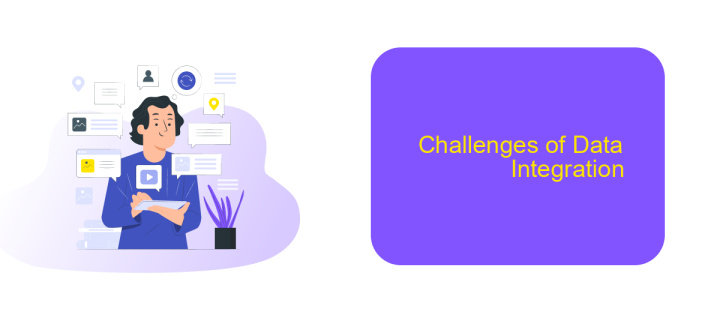Integration of Data
In today's data-driven world, the integration of data from diverse sources is critical for informed decision-making and operational efficiency. By seamlessly combining data from various systems, organizations can achieve a unified view, enhance analytics, and drive strategic initiatives. This article explores the methodologies, benefits, and challenges associated with data integration, providing insights into how businesses can leverage integrated data for competitive advantage.
Introduction
Data integration is a critical process that enables organizations to consolidate information from various sources into a unified view. This process is essential for making informed decisions, improving operational efficiency, and gaining a competitive edge. By integrating data, businesses can harness the full potential of their data assets, ensuring consistency, accuracy, and accessibility.
- Combining data from multiple sources
- Ensuring data consistency and accuracy
- Enhancing data accessibility and usability
- Facilitating informed decision-making
- Improving operational efficiency
One of the tools that can simplify the data integration process is ApiX-Drive. This service allows users to connect various applications and automate data transfers without requiring extensive technical knowledge. By utilizing ApiX-Drive, organizations can streamline their workflows, reduce manual errors, and ensure that data is consistently up-to-date across all systems. This results in more reliable data insights and better overall business performance.
Data Integration Techniques

Data integration techniques are essential for combining data from different sources into a unified view. One common technique is ETL (Extract, Transform, Load), which involves extracting data from various sources, transforming it into a suitable format, and loading it into a target database. Another popular method is ELT (Extract, Load, Transform), where data is first loaded into the target system and then transformed. These techniques ensure data consistency, accuracy, and reliability across the organization.
Modern data integration also leverages APIs and web services to facilitate real-time data exchange. Tools like ApiX-Drive simplify this process by providing a user-friendly interface for setting up integrations between various applications without the need for coding. ApiX-Drive supports a wide range of integrations, allowing businesses to automate workflows and synchronize data seamlessly. By utilizing such services, organizations can enhance their data integration efforts, leading to more informed decision-making and improved operational efficiency.
Benefits of Data Integration

Data integration is a crucial process for modern businesses aiming to leverage their data effectively. By consolidating information from various sources into a unified view, organizations can improve decision-making, enhance operational efficiency, and gain a competitive edge.
- Improved Decision-Making: Integrated data provides a holistic view, enabling better analysis and insights.
- Enhanced Efficiency: Streamlined data processes reduce redundancy and save time.
- Cost Savings: Reduced need for manual data handling lowers operational costs.
- Better Customer Experience: Unified data helps in understanding customer needs and personalizing services.
- Regulatory Compliance: Ensures data consistency and accuracy, aiding in compliance with regulations.
Services like ApiX-Drive can simplify the integration process, allowing businesses to connect various data sources seamlessly without extensive technical expertise. By automating data workflows, ApiX-Drive helps organizations maintain data integrity and focus on strategic initiatives rather than manual data management tasks.
Challenges of Data Integration

Data integration poses several challenges that organizations must address to achieve seamless and efficient data flow. One of the primary challenges is data inconsistency, which arises when data from different sources have varying formats, structures, or semantics. This inconsistency can lead to difficulties in data mapping and transformation, ultimately affecting the quality and reliability of the integrated data.
Another significant challenge is data security and privacy. Integrating data from multiple sources often involves handling sensitive information, making it crucial to implement robust security measures. Ensuring compliance with data protection regulations, such as GDPR, adds another layer of complexity to the integration process.
- Data inconsistency and heterogeneity
- Data security and privacy concerns
- Scalability issues with large data volumes
- Real-time data integration and synchronization
- Complexity in maintaining data quality
To address these challenges, organizations can leverage tools like ApiX-Drive, which simplifies the data integration process by providing a user-friendly interface and automated workflows. ApiX-Drive allows seamless connection between various data sources, ensuring data consistency and security, and enabling real-time data synchronization, thus enhancing the overall efficiency of data integration efforts.


Conclusion
In conclusion, the integration of data is a pivotal aspect for modern businesses seeking to harness the full potential of their information assets. Effective data integration allows for seamless communication between diverse systems, enhancing operational efficiency and fostering data-driven decision-making. By consolidating data from various sources, organizations can gain comprehensive insights, streamline processes, and ultimately achieve better outcomes.
Utilizing tools like ApiX-Drive can significantly simplify the process of data integration. ApiX-Drive offers a user-friendly platform that connects various applications and services, automating data transfer and synchronization without the need for extensive technical expertise. This not only saves time and resources but also ensures accuracy and consistency across all integrated systems. As businesses continue to evolve in the digital age, leveraging such integration solutions will be crucial for maintaining a competitive edge and driving innovation.
FAQ
What is data integration?
Why is data integration important for businesses?
What are the common challenges in data integration?
How can automation help in data integration?
What are the key features to look for in a data integration tool?
Routine tasks take a lot of time from employees? Do they burn out, do not have enough working day for the main duties and important things? Do you understand that the only way out of this situation in modern realities is automation? Try Apix-Drive for free and make sure that the online connector in 5 minutes of setting up integration will remove a significant part of the routine from your life and free up time for you and your employees.

